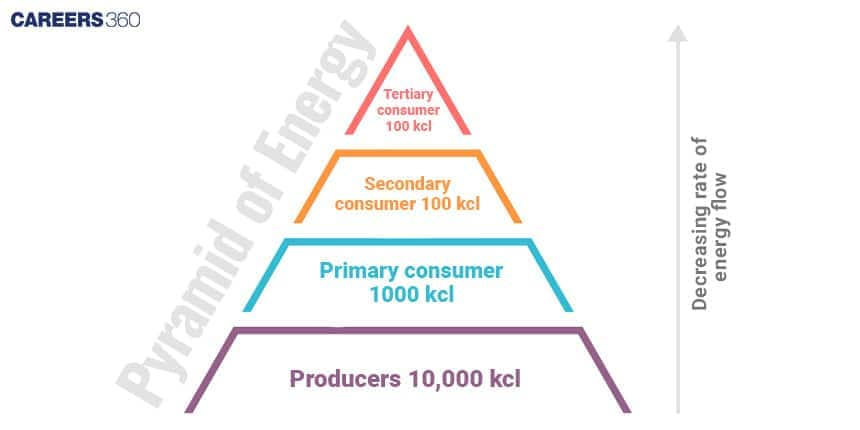Ecological Pyramids: Definition, Meaning, Types, Importance, Structures, Functions
An ecological pyramid is a graphical representation that helps in understanding the varying trophic levels in an ecosystem. It helps in understanding how energy, biomass, or the number of organisms decreases while moving up from the producers to higher trophic levels such as herbivores and carnivores. This is one of the topics which is considered fundamental for studying the dynamics of ecosystems in Biology.
NEET 2025: Mock Test Series | Syllabus | High Scoring Topics | PYQs
NEET Important PYQ's Subject wise: Physics | Chemistry | Biology
New: Meet Careers360 B.Tech/NEET Experts in your City | Book your Seat now
- What is an Ecological Pyramid?
- Importance of Ecological Pyramids
- Types of Ecological Pyramids
- Limitation of Ecological Pyramids

What is an Ecological Pyramid?
An ecological pyramid can be defined as a graphical representation where it shows the relationship between trophic levels in an ecosystem. They are used to describe the structure and functioning of energy transfer, biomass, and the number of organisms at each trophic level.
Also Read
Importance of Ecological Pyramids
Ecological pyramids are very important tools to understand the flow of energy, the distribution of biomass, and the population structure within the ecosystem. They help in picturizing the efficiency of energy transfer and identifying impotence potential imbalances in ecosystems.
Types of Ecological Pyramids
All three types of ecological pyramids are brought out that are pyramids of numbers, pyramids of biomass, and pyramids of energy. Each type gives a new vision concerning the structure and function of the ecosystem.
Pyramids of numbers indicate the population size of individual trophic levels.
Pyramids of biomass are the total mass of living matter at any level.
Energy pyramids are the flow of energy passage in the ecosystem which can tell us the efficiency at every trophic level.
Pyramid of Numbers
A pyramid of numbers describes the number of individual organisms at each trophic level in an ecosystem, but it usually has the shape of a pyramid because of the ample number of producers at the base and relatively smaller top number due to less number of top-level predators.
Forest Ecosystem: Many small plants at the base, fewer herbivores like deer, and even fewer top predators like tigers.
Grassland Ecosystem: Many grasses, herbivores like rabbits and fewer predators like hawks.
Inverted Pyramid in Parasitic Food Chains: A tree with many birds that are parasitized by still more fleas.

Pyramid of Biomass
A pyramid of biomass is a graphical representation of the total mass of organisms at each trophic level in a terrestrial ecosystem over a unit area.
High mass in trees as well as other plants which are further followed a step down by lesser mass of herbivores and then lesser mass of carnivores.
In some aquatic ecosystems, an inverted pyramid can be seen. The biomass of phytoplankton is less than that of zooplankton.

Pyramid of Energy
A pyramid of energy is a diagrammatic representation of energy flow through the trophic levels of an ecosystem over a given period. It normally is in a pyramid shape because of the loss of energy at each trophic level.
The forest ecosystem may have a large input energy at the base of the pyramid due to sunlight trapped by trees, but the aquatic ecosystem can have a different pattern in the flow of energy.

Limitation of Ecological Pyramids
The limitations of each type of pyramid are described below:
Pyramid of Numbers
Drawing a pyramid of this is deceptive as the size of animals isn't considered.
In parasitic chains or in several other ecosystems where the organisms are small, the pyramid can be inverted.
Pyramid of Biomass
Seasonally fluctuating biomass.
Inverted pyramids can be found in some ecosystems, such as aquatic systems where the biomass of primary consumers can be much larger than that of producers.
Pyramid of Energy
Is difficult, tedious, and time-consuming to collect data for energy transfer.
Only measures the quantity of energy rather than the quality or usability of the energy transferred.
Also Read
Recommended Video for Ecological Pyramids
Frequently Asked Questions (FAQs)
Ecological pyramids refer to the graphical representation of the relation between different trophic levels in an ecosystem based on numbers, biomass, or energy.
The pyramid of numbers depicts the number of organisms at every consecutive trophic level of an ecosystem, obviously with the number decreasing progressively up the trophic levels.
A pyramid of biomass can be inverted in aquatic ecosystems if the biomass of primary consumers at any time becomes quite high compared to the producers.
A pyramid of energy describes the movement of energy at every successive trophic degree over a given period with emphasis on energy loss at each stage and hence inefficiency of energy transfer.
Human activities disrupt energy flow in the pyramids, provide conditions for the reduction of biodiversity, and alter population structures. These may further result in declines or extinctions of species with very serious implications for stability and functioning in ecosystems.
Also Read
29 Nov'24 01:08 PM
25 Nov'24 08:54 AM
21 Nov'24 03:53 PM
21 Nov'24 01:52 PM
15 Nov'24 02:15 PM
14 Nov'24 09:05 AM
14 Nov'24 08:45 AM
13 Nov'24 10:19 PM